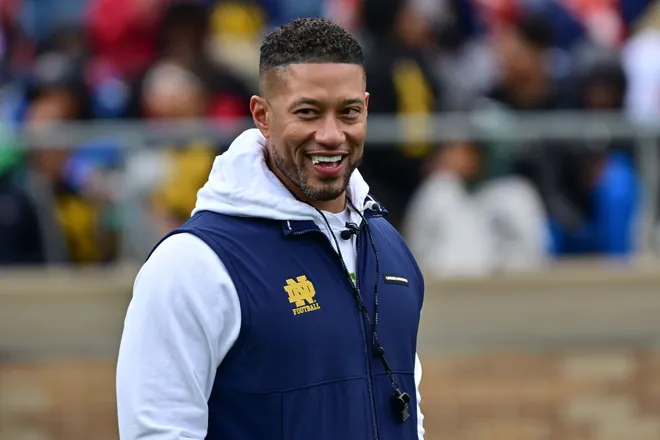
As the 2025 college football season approaches, Notre Dame Fighting Irish head coach Marcus Freeman is bracing for another year of high expectations, but with one key hope in mind: fewer injuries than his team faced in 2024. The 2024 season was a tumultuous one for the Fighting Irish, as a series of key injuries significantly impacted their performance. Freeman’s approach in the offseason, both in terms of player development and team health management, is centered on minimizing those injuries and ensuring the team can compete at the highest level throughout the year.
The Struggles of 2024: A Season Defined by Injuries
In 2024, Notre Dame found themselves dealing with a series of injuries to key players across the roster. Quarterback, offensive line, and key defensive positions all saw their fair share of setbacks, and the team’s depth was tested more than Freeman would have liked. The ripple effects of these injuries were felt in several games, as backups were thrust into starting roles, and certain position groups simply couldn’t maintain the same level of play when key contributors were sidelined.
One of the most notable instances was in the quarterback position. The Irish had a solid starter, but an injury during the season forced Freeman to rely on backup quarterbacks. This created instability on offense, as the timing and rhythm between the quarterback and his wide receivers were thrown off. The offense struggled to find consistency, and the defense, while still strong, had to bear a heavier load due to the lack of offensive production.
The offensive line, a group traditionally known for its toughness and ability to protect the quarterback, was also affected by injuries. Losing starting linemen disrupted the continuity of an already challenging unit. The line’s inability to maintain the same level of protection for the quarterbacks and open running lanes for the backs put a greater burden on the team’s offensive schemes. Although Notre Dame has depth in their recruiting and training programs, there is no substitute for experienced players, especially in the trenches.
Defensively, the Irish weren’t immune to injury woes either. Some of their best playmakers in the secondary and at linebacker missed significant time, which led to missed tackles, blown coverages, and an overall lack of cohesion on that side of the ball. While the defensive unit still showed flashes of greatness, the absence of key players left Notre Dame unable to fully execute its game plans in some of the most critical matchups.
As the 2024 season unfolded, Freeman faced the challenge of trying to plug holes and make do with the pieces he had, but the impact of these injuries was undeniable. Whether it was depth issues or simply not having the right personnel on the field at the right time, Freeman and his coaching staff had to manage a season filled with uncertainty and what-ifs.
Looking Ahead: Freeman’s Focus on Injury Prevention
Heading into the 2025 season, Freeman’s primary goal is to avoid a repeat of the injury-ridden year that defined 2024. He knows that a successful season hinges not just on the Xs and Os, but also on the health of his players. That’s why Freeman has turned his attention to developing a comprehensive strategy for injury prevention, player health, and overall team conditioning.
1. Strengthening the Strength and Conditioning Program
One of the key areas Freeman has focused on in the offseason is the strength and conditioning program. In consultation with Notre Dame’s athletic training staff, Freeman has implemented adjustments to the offseason workouts, making sure that players are physically prepared for the rigors of a long college football season. The goal is to build stronger, more resilient bodies that can withstand the physical demands of the game.
The strength and conditioning program now places a greater emphasis on flexibility, mobility, and injury prevention, particularly in high-risk areas such as the knees, ankles, and shoulders. With the guidance of experienced strength coaches and athletic trainers, Freeman hopes to build a team that is less prone to injuries by enhancing their physical preparedness for the season ahead.
2. Sports Science and Technology Integration
In addition to the physical preparation, Freeman is increasingly embracing the use of sports science and technology to monitor player health. This includes incorporating advanced analytics into training regimens to assess player fatigue levels, stress markers, and recovery needs. The integration of wearable technology, such as GPS trackers and heart rate monitors, helps Freeman and his staff gain deeper insights into each player’s workload and physical condition.
By utilizing data-driven approaches, Freeman hopes to identify potential injury risks before they become major problems. For example, if a player is consistently running at a high intensity during practice, coaches can adjust the player’s workload to prevent overuse injuries. Likewise, players’ recovery metrics, such as sleep quality and muscle fatigue, are closely monitored to ensure they are ready for game day.
3. Building Depth and Developing Young Talent
One of the more subtle, yet significant, adjustments Freeman has made is to increase the emphasis on developing younger talent across all position groups. In the event of an injury to a starter, Freeman wants to ensure that the team has capable backups who are ready to step in and perform at a high level. While Notre Dame has long been known for its strong recruiting classes, Freeman’s coaching staff has put an even greater emphasis on developing the next generation of talent through more practice reps and competitive drills.
By fostering competition and ensuring that every player on the roster has a legitimate chance to contribute, Freeman hopes to maintain a high level of performance, even if the team is hit by injuries. This approach, which emphasizes depth over just talent, also serves to build a more cohesive team where players are constantly pushing each other to improve. For a team like Notre Dame, which has championship aspirations, depth can be the difference between a successful season and one marred by injuries and inconsistent play.
4. Strategic Rest and Load Management
While college football is known for its grueling schedule and physical demands, Freeman has adopted a more strategic approach to rest and load management. Recognizing that players need more than just physical conditioning, Freeman has made it a point to balance tough training sessions with appropriate rest periods. The goal is to prevent burnout and overuse injuries by giving players the time they need to recover both physically and mentally.
During practices, Freeman’s staff carefully manages the amount of contact and high-intensity drills that players participate in. Players who have a higher risk of injury, such as those in physically demanding positions like offensive linemen, linebackers, and running backs, are given additional rest days to ensure they are at full strength come game day. The importance of mental health is also acknowledged in Freeman’s approach, recognizing that maintaining a strong psychological well-being is key to preventing injuries that can occur from fatigue or lack of focus.
5. Collaborating with Medical Staff
Freeman has fostered a strong relationship with Notre Dame’s medical staff, and he places a heavy emphasis on maintaining open communication regarding player health. Injuries, when they do occur, are closely monitored and managed by a team of experienced doctors and physical therapists. In addition to traditional injury rehabilitation, Freeman is also looking into alternative recovery methods, such as cryotherapy, deep tissue massage, and other cutting-edge treatments that could accelerate the healing process.
Moreover, Freeman has been proactive about mental health and the recovery process. The physical recovery of athletes is paramount, but Freeman is also very aware of the psychological toll injuries can take on players. Maintaining a strong support system for players who are recovering from injuries is a priority, ensuring they are mentally prepared to return to the field when the time comes.
6. Learning from the Past: Adjusting Game Plans
Freeman understands that some injuries are inevitable. That’s part of the game. However, part of his strategy for 2025 also revolves around making adjustments to his game plans that minimize the risk of injury. He’s looking to optimize play calling, especially in high-impact positions, to reduce unnecessary risks. For example, incorporating more quick passes and moving the pocket to protect the quarterback, as well as implementing a more rotation-heavy approach in the trenches, can reduce wear and tear on key players.
By diversifying his offensive and defensive strategies, Freeman hopes to create more opportunities for his team to succeed without forcing players into situations where injury is more likely.
A Season Built on Health and Resilience
As Marcus Freeman prepares for the 2025 season, he understands that success is built not just on talent but on the ability to remain healthy and resilient. The lessons learned from the 2024 season have shaped Freeman’s approach to this year’s campaign, and he is determined to do everything in his power to avoid the injury troubles that plagued the Fighting Irish a year ago.
With a stronger emphasis on injury prevention, player development, and team depth, Freeman is optimistic that Notre Dame will be able to navigate the 2025 season with fewer setbacks. The Irish have the talent, the coaching staff, and the resources to compete at the highest level, but the true key to their success will be their ability to stay healthy, both physically and mentally. If Freeman and his staff can manage the health of their players effectively, the Fighting Irish will be primed for a successful run at a championship in 2025.





